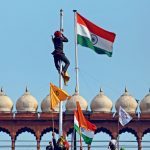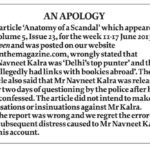Stirrings of a Right Revolution
Is it the end of Hindu victimhood?
 Swapan Dasgupta
Swapan Dasgupta
 Swapan Dasgupta
Swapan Dasgupta
 |
07 Mar, 2014
|
07 Mar, 2014
/wp-content/uploads/2015/11/dasgupta-stirring.jpg)
Is it the end of Hindu victimhood?
Sometime in the mid-1990s, when Prime Minister PV Narasimha Rao and his able Finance Minister Manmohan Singh were busy rewriting the script for the Indian economy, I attended a small meeting of ‘like-minded’ journalists at the Pandara Park residence of the BJP leader LK Advani. Apart from Advani, the BJP was represented by KR Malkani who, apart from his long association with the ‘movement’, was also regarded as a party ideologue. The agenda was modest: to achieve a measure of clarity over a proposal to allow foreign equity participation in the media.
As someone firmly committed to the dismantling of protectionist barriers, I argued that the media could hardly claim special status. In any case, I ventured to suggest, the BJP should not be averse to the proposed move: it was a party committed to deregulation and nationalism. This assertion agitated Malkani no end. “Yes,” he snapped at me, “but not in that order.”
Malkani’s may have been a slightly irascible aside directed at someone he probably regarded as an ideological interloper but it encapsulated a dilemma that has confronted the BJP ever since India formally turned its back on the economics of socialism in 1991. Should the BJP be a classical Centre-Right party in the mould of the Conservatives in Britain and the Christian Democrats in Germany? Alternatively, should it place its commitment to ‘cultural nationalism’ above all else?
The choices confronting the BJP aren’t unique. Almost all Centre-Right political formations have at some time or another been forced to determine the relative weightage to be accorded to market economics and national culture. This wasn’t much of a problem in the West in the days when there was a cosy Right-Left consensus over an ever-expanding state. Till the 1980s when Margaret Thatcher and Ronald Reagan reshaped the political agenda, Right-wing parties were either staid ‘conservative’ parties emphasising the virtues of the Establishment, tradition, humane capitalism and benign (but robust) nationalism or groups that were inspired in different ways by militarism, street fights and flag waving. The Thatcher and Reagan revolutions not only re-established the moral and political superiority of market economics but also made it possible for the practitioners of statecraft to consider rolling back the frontiers of the State.
At the same time, the Right was confronted with a new problem. The growing primacy of market economics contributed to the steady breakdown of national barriers in the path of international trade and investment. From a ‘customs union’, the Treaty of Maastricht transformed the European Union into a super-state and the World Trade Organization eroded national sovereignty quite insidiously, but with the associated promise of material prosperity. With the ignominious Soviet defeat in the Cold War, globalisation did not quite end the emotional attachments of the nation- state. However, in the dominant discourse of the age, it made nationalism less ‘respectable’. It is significant that even the multiple voices opposed to globalisation are couched in either Leftist or ‘post-ideological’ idiom. The conventional nationalist espousal of national sovereignty has, by and large, been squeezed into the so-called ‘far-Right’ domain. In the popular imagination, the defence of the national in an increasingly shrinking world is a grandstanding associated with Anders Breivik, the Norwegian neo-Nazi who killed 77 people in a bout of frenzy in 2011.
The marginalisation of yet another pillar of conservative political belief has been equally dramatic. Till about the first seven decades of the 20th century, the established Christian churches were known to side quite unequivocally against the forces of the Left. In post-War Italy, the Catholic church was the most formidable and dependable bulwark against the Communists; in Britain, the dominant Church of England was also described as the ‘Conservative Party in prayer’; and in the United States, the equation of church and conservatism (extending along formal party lines) was almost complete. The social upsurge that began in protest against the Vietnam war and soon came to embrace issues such as race and gender led to a steady secularisation of European (and to a lesser extent, American) society. The moral authority of the established Christian churches was considerably eroded and modern common sense internalised the belief that religion should be kept out of public spaces, including statecraft. No doubt the collapse of the Soviet Union and the revival of Christianity in eastern Europe checked the quantum of secularisation—to which was added the growing popularity of Christian evangelism in the US. But overall, the intellectual mood became increasingly anti-faith. Quite paradoxically, the weakening of Communism as a political movement was also accompanied by the rising appeal of certain tenets of Left-wing faith.
To add to the muddle, there was the spectacular rise in the appeal of political Islam, particularly after the Iranian revolution of 1979 and the victory of the mujahideen forces in Afghanistan following the Soviet invasion of that country. The notion of the Islamic ummah, which had hitherto been a subsidiary and largely ignored aspect of the larger Muslim faith, now acquired traction. Osama bin Laden and his dramatic displays of death and destruction conferred upon Islamism a global notoriety but it also reshaped the larger political assumptions of Muslims throughout the world. In the non-Muslim world, Islamism generated contradictory responses. To the metropolitan upholders of globalisation, it confirmed the efficacy of the secularisation process. Unflinching religious faith, it was concluded, was a regressive phenomenon and had to be firmly relegated to the fringes of modernity. At the same time, the opponents of George W Bush’s ‘war on terror’ believed that the rough edges of Islamism could be blunted through moral relativism and accommodation. According to the emerging Liberal dogma, ‘fundamentalism’ couldn’t be destroyed; it had to be tamed through multicultural initiatives. The threatened clash of civilisations, it was felt, could best be averted through the creation of multiple identities and a forthright repudiation of the very idea of national cultures.
Indian politics has only too often been studied in national isolation, and without attaching undue importance to the larger global backdrop. This approach may not have been out of place till the end of the 1980s when India’s exposure to global influences was at best patchy and limited to a very thin layer of the elite and the Communist movement. The economic course correction undertaken after 1991 was a point of rupture. In the past 25 years or so, the quantum of economic growth has equalled that witnessed over the course of the preceding 150 years. The very slow, gradual social transformation that India witnessed throughout much of British rule and the Jawaharlal Nehru-Indira Gandhi years has been encapsulated in a remarkably short period. People’s living standards, awareness brought about by education and global exposure, and their collective aspirations have changed quite significantly in the course of a generation. These changes are now starting to be reflected in politics.
For the Indian Right, the effects have been dramatic. In the Nehru-Indira years, there were two strands in the political Right. There was, first, the Jan Sangh (the predecessor of the BJP) which was committed to a Hindu nationalism whose intellectual origins lay in the pre-Gandhian nationalist movement and Partition. Secondly, there was the Swatantra Party which was a strange amalgam of Princely India and embryonic capitalism. Neither formation could make any significant headway in the face of a Congress, which, apart from inheriting the political legacy of the national movement, also encapsulated the quasi-socialist urges of struggling Third World economies.
Two events catapulted the Indian Right to centre-stage. The first was the short-lived Janata Party experiment. Apart from institutionalising democracy, the Janata experience proved invaluable in establishing an alternative tradition based on coalition politics.
The second event in the form of the Ram temple movement was more consequential. For a start, the mobilisation spread over nearly five years enabled the Hindu Right to connect with peoples and communities spread across India that had hitherto not been exposed to alternative traditions. The direct impact of this was on the political fortunes of the BJP. By 1991, the BJP had successfully positioned itself as the ‘alternative pole’ of politics. At the same time, the passions aroused by the Ram temple movement led to a ganging-up of forces against the BJP. Because its spectacular surge had been due to its forceful articulation of ‘cultural nationalism’, the BJP became a single-issue force and was imperfectly positioned to respond to other issues and other forces.
After 1991, for example, there was genuine confusion inside the BJP over its responses to economic liberalisation. Instinctively, the party stood for deregulation, decentralisation and small government. However, since these impulses were simultaneously linked to the opening up of the Indian economy to global competition, it was unsure of whether to welcome the change or retreat into a swadeshi inheritance. Even today, the issue hasn’t been conclusively resolved and often reappears in battles over insurance, retail and rupee convertibility. Yet, the confusion isn’t as marked as it was in the mid-1990s. I recall at that time asking a very senior BJP leader whose interest in economic issues was perfunctory, how the party would resolve the problem. His answer was simple but memorable: “We will never fight an election on economic issues.”
The candour was revealing and, in hindsight, testified to the fact that the Indian political class was unaware of the extent to which politics and economics would merge to squeeze out the culture wars. The BJP fought the 1991 election on the Ram temple issue. In 1996, cultural nationalism was not that prominent but it was the memories of the Ayodhya demolition that ensured Atal Behari Vajpayee’s failure to secure a parliamentary majority after 13 days. What is significant is that since then, the BJP has fought its electoral battles over leadership, the promise of good governance and, in 2004, on an out-and-out economic platform.
In 2014, with Narendra Modi at the helm, the BJP platform is an epitome of conventional Right-wing politics: decisive leadership, rapid economic growth, a rollback of an inefficient state, uncompromising national security and an all-inclusive patriotism. Not once in his many speeches across the country has Modi mentioned the many little culture wars that agitate the minds of Hindu activists but leave the rest of India both irritated and exasperated.
Does this imply that Modi has succeeded in doing what Vajpayee set out to do after 1998: to merge the parallel strands of cultural nationalism and capitalism with an Indian face?
It is still too early to proffer a conclusive answer but certain trends are noteworthy. Modi rose to national prominence and acquired notoriety in liberal circles after his transformation into Chhote Sardar in the wake of the 2002 riots. There is no doubt that Modi successfully turned victimhood on its head and rode the crest of a Gujarati backlash in the election that followed the riots. However, since then Modi has successfully reinvented himself as the administrative and economic reformer extraordinaire—a man who is in a tearing hurry to destroy sloth, mediocrity and jugaad. Maybe, it was the image of a Gujarati Shivaji that endeared Modi to his party but the awesome incremental support he has secured all over India subsequently owes only nominally to his Hindutva credentials. It has almost everything to do with the fact that in a period of utter despondency, people see him as a leader capable of delivering an economic miracle.
For the Indian Right, the transformation promises to be revolutionary. The shift in relative weightage from culture to economics wasn’t the result of deep introspection. In fact, Indian politics still remains remarkably discussion-free. It was pressure from below that dictated the choice of its leader and his agenda. The cadres and political class merely responded to the stirrings on the ground. Success in the polls promises an enduring change in the character of the Right; failure guarantees regression and the rediscovery of Hindu victimhood.
India has changed dramatically and is in the process of reordering its priorities. The Indian Right is only beginning to learn that its old certitudes count for very little now.
Swapan Dasgupta , a Delhi-based political commentator, is a self-confessed conservative and part of India’s beleaguered Right
About The Author
CURRENT ISSUE
Rashmika Mandanna: India’s Sweetheart
MOst Popular
4

/wp-content/uploads/2025/04/Cover-Rashmika-New.jpg)











More Columns
Saving Farmers from the Unions Siddharth Singh
The New Hotspot Kaveree Bamzai
Chills and Spills in Small Town America Kaveree Bamzai